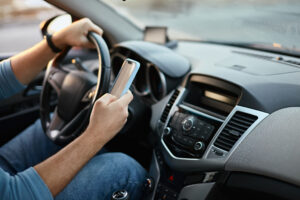
IIHS contends phones can be used to mitigate distracted driving
By onTechnology
While cell phones are often associated with distracted driving, the Insurance Institute of Highway Safety (IIHS) reports they can also aid in mitigating driving distractions.
“Our phones also offer a great defense against distraction — a ‘do not disturb’ feature that can block incoming calls and notifications while the user is driving,” wrote IIHS Senior Research Scientist Ian Reagan. “Other apps have the potential to reduce other types of distracted driving, encourage safer speeds and provide basic crash avoidance capabilities for every vehicle in the U.S. fleet. What’s more, the biggest players in the smartphone industry are eager to be part of the solution.”
However, Reagan noted — as previous National Highway Traffic Safety Administration (NHTSA) reporting has shown — that police report crash data indicates around 3,350 people were killed in distraction-related crashes and 382 died in crashes involving cell phone use in 2021.
A recent NHTSA report suggests the real death toll from all types of distraction could be as much as three times higher, with cell phones at fault in at least 6% of the crashes.
While safety features in vehicles take decades of research toward implementation, Reagan says there’s hope that they’ll make it to phones quicker and aid in cutting down on distracted driving. He cited GPS as an example of successful use in vehicles via phones when the feature gained use in millions of vehicles as soon as Apple and Google rolled out their navigation apps.
“The same thing can happen with safety features,” Reagan wrote. “Not too long ago, when the first ‘do not disturb’ apps for driving came out, my colleagues and I saw little point in studying them, as they were not prominent enough for many users to know about them. Then one day Apple changed the initial setup procedure for the iPhone so every new user was asked if they wanted to block calls and notifications automatically whenever they were driving.
“Not long after, we determined that a disheartening 1 in 5 users opted in. But that simple move by Apple opened the door for IIHS and others to start researching how to make the feature more effective and get more people to use it.”
And tech companies, such as Google, continue to work with IIHS, other road safety advocates, the Alliance for Automotive Innovation (Auto Innovators), and regulators to raise awareness about and prevent distracted driving with recently showcased technologies.
Those technologies included in the showcase were driver monitoring systems, restriction- and automated enforcement-based prevention features and crash avoidance features.
IIHS backs recent updates to “do not disturb” features that allow urgent message alerts, music, directions, and basic web search use with voice commands because they’re more likely to be used by drivers. “Still more could be done to encourage adoption,” Reagan wrote. “Google and other phone makers should emulate Apple and ask users during a phone’s initial setup if they want the ‘do not disturb’ function to turn on automatically when the device detects that the user is driving.
“Even better, they could make that the default setting, so that users don’t have to opt in to have their calls and notifications blocked while driving. To make it more robust, the feature could be designed to turn on automatically with each new drive and require the user to switch it off each time they want to override it. Other easy targets include measures to limit the functionality of video players and games or at least prevent their use on the vehicle’s console display.”
He used SnapChat’s virtual speedometer overlay as an example, which allegedly played a role in multiple high-speed fatal crashes involving young drivers.
IIHS says regulators should follow Europe’s example and mandate intelligent speed assistance (ISA) in vehicles. The feature alerts drivers when they’re exceeding the speed limit and became a requirement on vehicles in Europe with the 2022 model year. Waze, Reagan noted, already offers a similar feature to ISA.
“Coupled with modest incentives, my research shows ISA substantially reduces the amount of time drivers spend traveling above the speed limit,” he wrote. “Those incentives are already out there, too, in the form of the ‘safe driver’ apps now offered by most insurance companies, which reward drivers for demonstrating good habits with lower premiums. With the right laws and regulations, similar technology could be used to change the behavior of people who violate traffic safety laws.”
Smartphones can also be used to substitute some safety features in vehicles that aren’t equipped with them through use of apps that provide forward collision warning (FCW) through the phone’s forward-facing camera. Since many vehicles on the road today lack automatic emergency braking (AEB), Reagan thinks, as long as the apps work well, they could fill that gap. Other apps are in development that would use phone cameras to monitor driver eye movements and head directions to provide alerts when distractions occur.
“While most automakers have fulfilled a voluntary commitment to install AEB in virtually every vehicle they build for the U.S. market, it will be nearly 2050 before the entire U.S. fleet is equipped with it,” he wrote. “In the meantime, if an app could provide FCW that meets the U.S. regulatory requirements for in-vehicle systems, everybody with a phone would instantly have access to a valuable driver assistance feature.”
According to IIHS research, those warning systems reduce police-reported rear-end crashes by 27%, even without AEB.
“Distraction has been causing crashes since people began driving. Our screen addiction has both added to the problem and drawn new attention to it,” Reagan wrote. “If the smartphone could become a tool to combat not only device-based distraction but also other types of distraction and unsafe driving, that would be a truly remarkable turnaround.”
Images
Featured image credit: perfectlab/iStock
